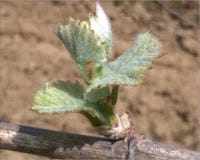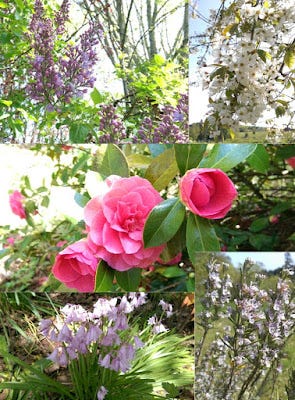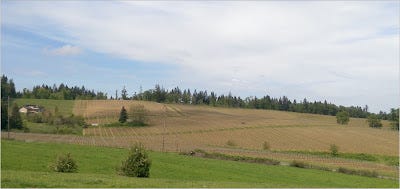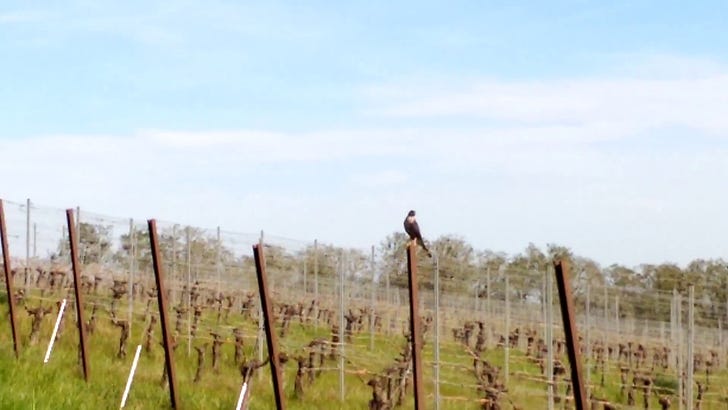Amalie Robert Estate Climate Update: 2018 April
Hello and Welcome,
This is the 2018 April Climate Update from Amalie Robert Estate. A FLOG communication.
Springtime in Wine Country is almost as exciting as harvest. There are sunny days and rainy days. Warm temperatures and cool temperatures. Hail is mostly a Springtime event, however we are sure that with all of the uncertainty in the world, that it may very well become a fall event. As in “What the hail!?”
End posts, they're not just for wires.
Click on the image to see our vineyard floor overseer in action.

And then there is budbreak. This is the sign we are looking for from Mother Nature. It shows us that the vines have wintered over from last year’s Cluster Pluck and they are ready for the growing season. As the first couple of leaves unfurl, the vines look like they are sporting a line of little green butterflies. This lasts about 14.7 seconds, and then they start growing like the fruit bearing vines they are. Raising catch wires is the next task on the horizon and approaching rapidly.
But wait, let’s enjoy the moment. Springtime in wine country also gives us a wonderful palate of blooms on all sorts of plants. Mother Nature really puts on a show! Colors, textures and aromas from all sorts of flora attract the ever busy bee and the cycle of pollination is carried out dutifully.

And Ernie has his own cycle this time of year. His job is to feed our vines. Sounds quite simple, and it is, really. But just like everything in farming, the devil is in the details. Let’s review, shall we?
His first job is to incorporate the cover crops he drilled in last fall. Note this pre-supposes that the cover crop got drilled in last Fall. And it did. Last fall the vineyard was treated to a cover crop blend of Austrian winter peas and barley. The idea here is to have the peas set Nitrogen in the soil and the barley to take it up and hold it until the spring.
Nitrogen is mobile in the soil. That means the winter rains will wash it away if there is not some plant to take it up from the soil. Just think of the peas as a solar panel generating electricity and the barley as the battery that holds that energy until the spring. That’s when Ernie comes along and turns the soil so that the Nitrogen is released into the soil and the vine roots can pick it up. That’s the goal, feeding our vines without the use of chemical fertilizers. These cover crop plants also hold the soil on the hill in the face of daunting winter rains. Ha, it’s a twofer!
So, Ernie’s first pass is with the virtually indestructible chisel plow. What a great piece of farming equipment. It is relatively inexpensive, does not require power from the tractor and is really hard, but not impossible, to break. This implement attaches to the crawler and Ernie drives it about 2 miles per hour through every other row. Ideally these are the rows with the cover crop and not the rows with the permanent grass.
Click on the image to see Ernie and the chisel plow in action.
The chisel plow also performs double duty. The primary objective is to open our silty clay loam Bellpine soil to make it easy for the (easy to break) rototiller pass. Seven shanks go down about 8 to 10 inches and open up the soil.
While those shanks are down there, they also perform a little root pruning. Vines are always trying to find soil moisture and the shallow roots pick up the easy soil moisture during the spring and fall. Ernie is having none of it. He wants deep roots to help the vines find soil moisture during the dry months of August and September. Ernie schedules his annual trip to the dentist after this pass to restore any loose fillings that may have gone missing.
Right, now it is on to the rototiller pass. The first step is to inspect and replace any broken tines from the fall cover crop regime. If he is lucky, he can skate by without having to replace any clutch disks. But this is farming, and usually if not for bad luck, there is no luck at all.
Click on the image to see Ernie and the rototiller in action.
The rototiller, for all its agrarian vagaries, does a very good job of incorporating the nitrogen rich cover crop plants into the soil where all manner of microbes, worms and other no-see-ums are waiting for them. It’s dinner time on the vineyard floor!
And it looks nice, all fluffed up like that. It is important to have a little air exchange in the soil. Most microbes are aerobic and they need oxygen to function properly. The rototiller does this at no extra charge. And it helps to level the rows and our side hills. Ernie had to terrace some parts of the vineyard due to the steep side slopes. The rototiller helps move the soil from the uphill side to the downhill side, making a level surface to drive on. The rototiller is not such a bad implement after all.
Next Ernie hooks up the Schmeiser seed drill! Woohoo! We are going to drill some cover crop now! This is the third and final pass in the cover crop rows, putting down the new summer cover crop seeds.
Click on the image to see Ernie and the Schmeiser in action.
Amalie Robert Estate is a dry farmed vineyard, we are “True to the soil and True to the vintage. ®” So the summer cover crops have to get by on the morning dew we receive from our on-shore flows coming in from the Pacific Ocean. These cover crops also have to provide nutrition for the voracious, carnivorous insects that roam the vineyard.
Lady bugs, earwigs, mites and all other manner of insects are on guard against cane borers and parasitic mites that feed on our vines. These good bugs are the front line of defense in keeping our vines healthy and producing world class wines.
And when they can’t find bad bugs to eat, you still have to feed them. That’s one reason we use Buckwheat and Vetch for our summer cover crop blend. These plants need very little water, produce pollen (which is protein) for our army of good bugs and will set Nitrogen to feed our vines in the fall.
When it is all said and done, Ernie makes 3 passes in every other row to set our vineyard floor straight for the growing season. It’s about 18 acres worth of land, or 20 lineal miles that he is cycling through. Those 3 passes combine to make a total of about 60 lineal miles, at about 2 miles per hour. This saves him from having to use chemical fertilizers to feed our vines, and that is a good thing. And he has to mow the permanent rows, twice, at 3 miles an hours - go speed racer! If you sent Ernie an e-mail in April and did not get a response, now you know why. What a Springtime workload this man has!

Ernie, right in the middle of it.
Now before we get onto the task of shoot positioning, raising catchwires, and harnessing all of the vine’s Springtime growth, let’s do the numbers while we still have time.
The high temperature for April was 82.90 degrees recorded on the 24th at 3:24 pm. The low temperature was 31.50 degrees recorded on the 3rd at midnight. After gently massaging 3,600 data points, we find an April degree day accumulation of 110.10 degree days. The second half of the month was responsible for 71% of the heat accumulation, logging 78.65 degree days.

And we start the 2018 growing season with our soils holding a good amount of moisture. Rainfall for April totaled 5.80 inches. As a dry farmed vineyard, our objective is to manage the available soil moisture through the summer growing season.
If we can make it to September, we usually can get a little rainfall to extend our ripening period into October. As we are all painfully aware after these last few vintages, sugar accumulation is a function of heat, and aroma and flavor are a function of time on the vine.
Kindest Regards,
Dena & Ernie



